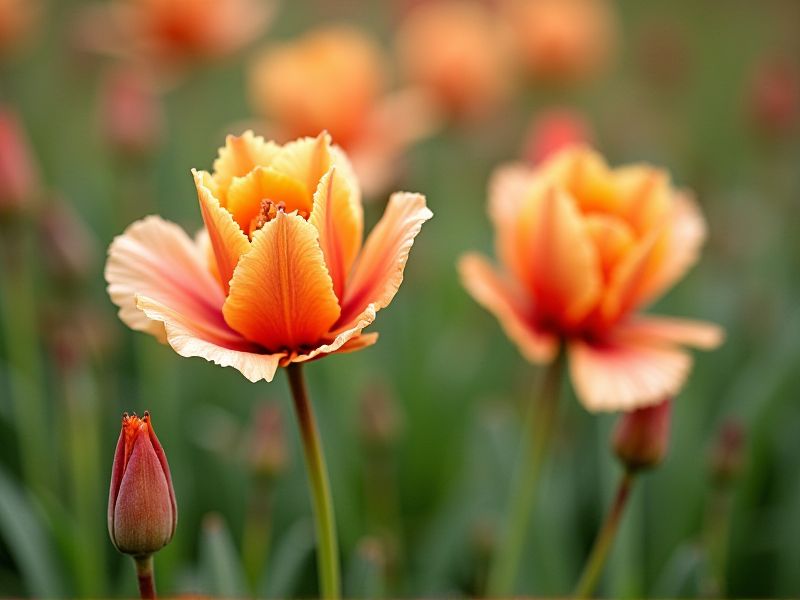
Drought-resistant plants, such as succulents and certain varieties of native wildflowers, thrive in arid conditions while providing stunning blooms. Examples include the vibrant desert marigold (Baileya multiradiata), which showcases bright yellow flowers, and the dramatic red yucca (Hesperaloe parviflora), known for its tall flower spikes. These plants not only conserve water through specialized adaptations like thick leaves or deep roots but also attract pollinators, enhancing your garden's biodiversity. Incorporating drought-tolerant species like the lavender (Lavandula) or blanket flower (Gaillardia) can create a colorful landscape that requires minimal hydration. Embracing these resilient plants contributes to sustainable gardening practices while ensuring aesthetic appeal.
List of some Drought-resistant plants that bloom
- Lavender (Lavandula)
- Coneflower (Echinacea)
- Blanket Flower (Gaillardia)
- Russian Sage (Perovskia atriplicifolia)
- Yarrow (Achillea millefolium)
- Lantana (Lantana camara)
- Black-Eyed Susan (Rudbeckia hirta)
- Sedum (Sedum spp.)
- Hummingbird Mint (Agastache)
- California Poppy (Eschscholzia californica)
Important things about Drought-resistant plants that bloom
Water-Efficient Adaptations
Drought-resistant plants, such as succulents, lavender, and other native species, are designed to thrive in arid conditions while providing vibrant blooms. These plants have evolved unique adaptations, including deep root systems and fleshy leaves, which allow them to store moisture efficiently. You can enhance your garden's resilience by selecting these water-wise options, as they require minimal irrigation once established. Incorporating such flora not only conserves water but also adds color and beauty to landscapes susceptible to drought.
Deep Root Systems
Drought-resistant plants often possess deep root systems that enable them to access water stored in the soil, allowing them to thrive in arid conditions. These plants, such as the desert marigold and California poppy, not only survive but also bloom vibrantly, showcasing their adaptability. By investing in deep roots, these species can withstand prolonged dry spells while contributing to ecosystem health and biodiversity. Choosing drought-resistant plants for your garden can enhance water conservation efforts while providing beautiful, resilient blooms throughout the growing season.
Drought-Tolerant Foliage
Drought-resistant plants that bloom offer a vibrant solution for gardens in arid regions, combining beauty with resilience. Selecting varieties such as lavender, yarrow, and gaillardia ensures you enjoy stunning flowers while conserving water. These flowering perennials not only tolerate dry conditions but also attract pollinators, enhancing biodiversity. Incorporating them into your landscape design can create a colorful oasis that thrives even in limited moisture.
Heat Resilience
Drought-resistant plants, such as succulents and native wildflowers, thrive in arid conditions, showcasing vibrant blooms while conserving water. Species like the Agave and Desert Marigold have adapted to withstand heat, featuring deep root systems that access underground moisture. These resilient plants not only enhance garden aesthetics with their colorful flowers but also play a vital role in supporting local ecosystems by attracting pollinators. Incorporating drought-tolerant varieties into your landscape can significantly reduce water consumption while maintaining a stunning display throughout the growing season.
Flowering During Dry Seasons
Drought-resistant plants that bloom during dry seasons are essential for sustainable landscaping in arid regions. Species like the Agave, Lavender, and Desert Marigold thrive under harsh conditions, showcasing vibrant flowers while conserving water. You can enhance your garden's beauty with these resilient plants, as they require minimal irrigation and offer an array of colors and textures. Incorporating such flora not only adds aesthetic value but also promotes biodiversity and ecological balance in your outdoor space.
Low Maintenance Requirements
Drought-resistant plants that bloom, such as succulents, lavender, and agave, are ideal choices for low-maintenance gardens. These plants have adapted to arid conditions, allowing them to thrive with minimal water, making them perfect for xeriscaping. By incorporating varieties like salvia and stonecrop, you can enjoy vibrant flowers while conserving resources and reducing overall gardening upkeep. Transform your landscape with these resilient, colorful options that not only beautify your space but also promote sustainability.
Attractive To Pollinators
Drought-resistant plants such as lavender, agave, and succulents not only thrive in arid conditions but also attract a variety of pollinators, including bees and butterflies. These plants often produce vibrant flowers that offer essential nectar and pollen, supporting local ecosystems. Incorporating these species into your garden can enhance biodiversity, providing refuge for beneficial insects while reducing water usage. By selecting drought-tolerant blooms, you create an eco-friendly space that nurtures wildlife and conserves resources simultaneously.
Varied Color Options
Drought-resistant plants that bloom come in a stunning array of colors, making them not only practical but also visually appealing for any landscape design. Popular options include the vibrant red of Zinnia, the cheerful yellow of Coreopsis, and the calming lavender hues of Russian Sage. These resilient perennials are specially adapted to thrive in arid conditions, showcasing their bright blossoms even while conserving water. By incorporating these colorful drought-tolerant plants into your garden, you can create a thriving, low-maintenance oasis that attracts pollinators and provides year-round interest.
Soil Improvement Capabilities
Drought-resistant plants, such as succulents, native grasses, and certain flowering perennials, play a vital role in soil improvement by enhancing soil structure and moisture retention. These plants not only survive in arid conditions but also contribute organic matter to the soil as their leaves and roots decompose, enriching its nutrient profile. By utilizing deep root systems, they help loosen compacted soil, promoting better water infiltration and aeration. Choosing drought-resistant blooms for your garden not only conserves water but also supports biodiversity and creates a vibrant, sustainable landscape.
Suitable For Xeriscaping
Drought-resistant plants that bloom are essential for xeriscaping, providing vibrant color while conserving water. Popular choices include the heat-tolerant lantana, known for its clusters of colorful flowers that attract butterflies, and the resilient blanket flower, which thrives in poor soil and produces bright, daisy-like blooms. Consider incorporating desert marigold for its sunny yellow flowers and longevity, as well as salvia, which offers both drought resistance and fragrant purple spikes. By selecting these hardy plants, you can enhance your garden's aesthetic appeal while significantly reducing water usage.
